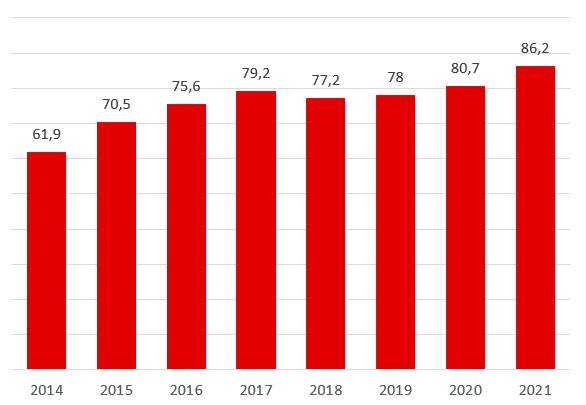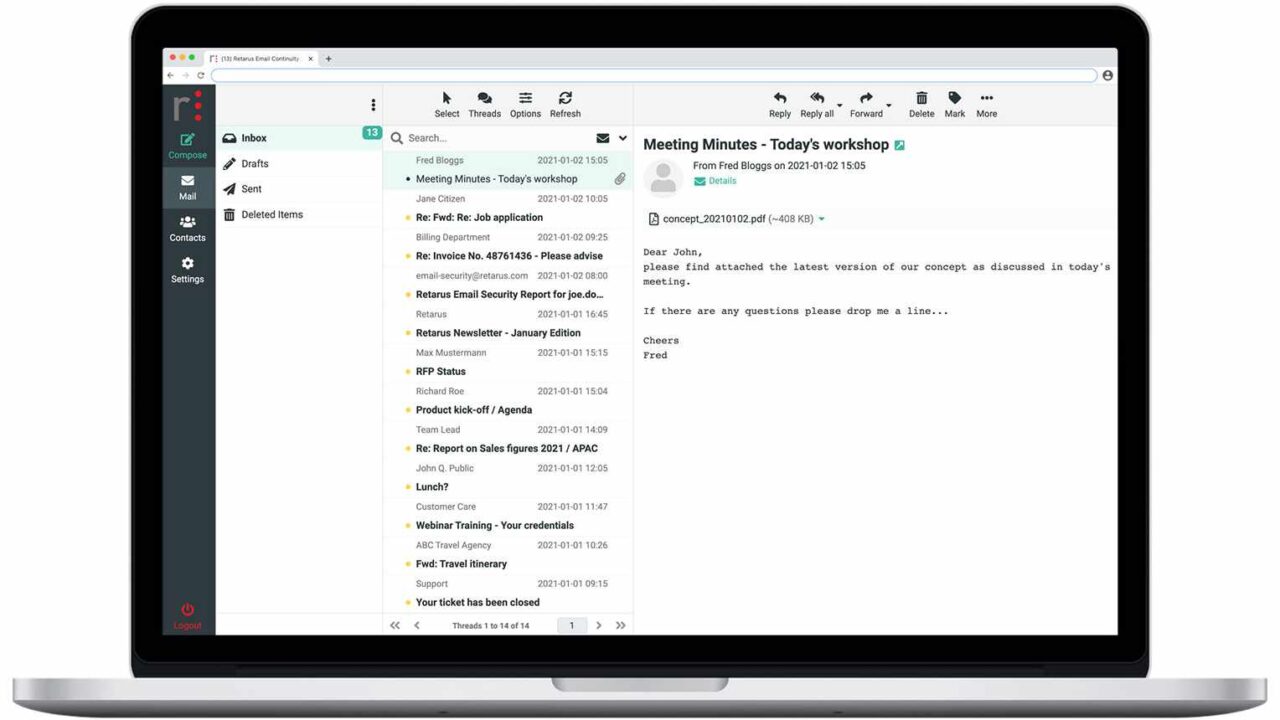Das Jahr 2020 hat Unternehmen wie Privatpersonen vor beispiellose Herausforderungen gestellt. Angesichts einer globalen Pandemie, gigantischer Waldbrände und politischer Unruhen wird eine weitere schwerwiegende Gefahr leicht vergessen: 2020 hält auch den Rekord für die meisten Datenverluste und Cyberangriffe weltweit – und 2021 übertrifft seinen Vorgänger bereits. Wir präsentieren alarmierende Cybersecurity-Statistiken und wagen auch einen Blick in die Zukunft.

Quelle: Cyberedge Group 2021 Cyberthreat Defense Report
Firmen mangelhaft vorbereitet
Trotz aller Warnungen und Schlagzeilen sind die meisten Unternehmen in Sachen IT-Sicherheit nur unzureichend vorbereitet:
- Fast 80 Prozent der leitenden IT-Mitarbeiter und IT-Security-Verantwortlichen glauben, dass ihre Firmen nicht ausreichend gegen Cyberangriffe geschützt sind – trotz erhöhter Investitionen in die IT-Sicherheit im Jahr 2020.
- Jeder Mitarbeiter hat Zugriff auf durchschnittlich 11 Millionen Dateien – aber nur 5 Prozent aller Firmenordner sind ausreichend geschützt.
- Nur 57 Prozent aller Unternehmen haben 2020 eine Risikobewertung in Sachen Datensicherheit durchgeführt.
- Mehr als Dreiviertel (77 Prozent) aller Firmen haben keinen Response-Plan für IT-Security-Vorfälle.
- Mehr als 93 Prozent der Unternehmen im Gesundheitswesen haben in den letzten drei Jahren mindestens eine IT-Sicherheits-Verletzung gemeldet.
Jede Minute gehen weltweit 2,9 Mio. US-Dollar durch Cyberkriminalität verloren.
Forbes
Exorbitante Kosten bei Verletzungen der IT-Sicherheit
Die Kosten für IT- und Datenschutz-Verletzungen sind in den letzten Jahren stetig gestiegen. Die vermehrte Umstellung auf Homeoffice im Jahr 2020 hat viele neue Schwachstellen geschaffen und die Angriffsfläche für Cyberattacken stark vergrößert. Darüber hinaus haben automatisierte Angriffe und die Möglichkeit, Kryptowährungen über Ransomware zu tauschen, die Kosten der IT-Kriminalität in die Höhe getrieben:
- Spitzenunternehmen verlieren pro Minute 25 US-Dollar aufgrund von Cybersecurity-Verletzungen.
- 2020 betrugen die Kosten für eine Verletzung der Datensicherheit durchschnittlich 3,86 Millionen US-Dollar.
- Die Zeitspanne, bis eine Verletzung der IT-Sicherheit identifiziert und eingedämmt wurde, betrug 2020 im Durchschnitt 280 Tage.
- Die Gesundheitsbranche hat 2019 geschätzte 25 Milliarden US-Dollar durch Ransomware-Angriffe verloren.
- Die Cyberkriminalität wird die Welt bis 2025 voraussichtlich 10,5 Billionen US-Dollar pro Jahr kosten.
![Durchschnittliche Kosten der weltweiten Cyberkriminalität [in US Dollar]](https://www.retarus.com/blog/en/wp-content/uploads/sites/22/2024/05/Durchschnittliche-Kosten-Cyber-Kriminalitaet-weltweit.png)
Quelle: McAfee Report “The Hidden Costs of Cybercrime”
Immer mehr und deutlich schädlichere Cyberangriffe
Nicht nur die Anzahl der IT-Angriffe ist in den letzten Jahren deutlich gestiegen, sie sind auch erheblich raffinierter geworden. Grund hierfür ist der vermehrte Einsatz neuer Techniken wie Machine Learning / KI. Hinzu kommt die verstärkte Zusammenarbeit zwischen Hackergruppen und staatlichen Akteuren.
Die Gesamtmenge an Malware ist seit 2019 um 358 % gestiegen – an Ransomware sogar um 435 %.
Forbes
Die verschiedenen Bedrohungen: Malware, Phishing, Ransomware
Phishing wird von den meisten Hackern nach wie vor bevorzugt, weil es einfach umzusetzen und oft erfolgreich ist. Cyberkriminelle finden schnell immer neue Möglichkeiten, um auch verstärkte Sicherheitsvorkehrungen zu umgehen. Die Malware bahnt sich weiter ihren Weg:
- Jeden Tag gibt es 100.000 neue bösartige Websites und 10.000 neue bösartige Dateien.
- Mehr als 80 Prozent aller gemeldeten Sicherheitsvorfälle sind Phishing-Angriffe.
- Google hat im Januar 2021 über 2 Millionen Phishing-Websites registriert nach 1,7 Millionen im Januar 2020. Das entspricht einem Anstieg von 27 % in nur zwölf Monaten.
- 2019 war 93,6 Prozent der beobachteten Malware polymorph, das heißt sie ändert ständig ihren Code, um nicht entdeckt zu werden.
- 2020 versuchten Angreifer auch, von der Corona-Pandemie zu profitieren, und unterbrachen kritische Lieferketten. Angriffe auf Lieferketten nahmen in nur zwölf Monaten um 420 Prozent zu.
- In Zukunft werden Deepfakes und Desinformation noch gefährlicher als heute werden.
94 % aller Malware wird via E-Mail verbreitet.
CSO
Aufholbedarf bei Maßnahmen für die IT-Sicherheit
Angesichts der drohenden Kosten und Datenverluste erkennen Unternehmen zunehmend, dass sie mehr Geld für ihren IT-Schutz ausgeben müssen, und planen ihre Budgets entsprechend. Doch es gibt noch viel zu tun:
- 2019 wurden bei 60 Prozent der IT-Angriffe Schwachstellen ausgenutzt, für die ein Patch verfügbar gewesen wäre.
- Fast 50 Prozent der Firmen-PCs, die sich 2019 einmal Schadsoftware einfingen, infizierten sich innerhalb desselben Jahres erneut.
- Kleinere Unternehmen mit bis zu 250 Mitarbeitern bekommen die meisten bösartigen E-Mails – eine aus 323.
- Zwei Drittel der Unternehmen werden einen Teil ihres erhöhten IT-Budgets auch für die Einhaltung von Gesetzen und Vorschriften im Bereich Datenschutz ausgeben. Viele der Unternehmen beklagen dabei, dass diese Compliance-Vorgaben sie von ihrer eigentlichen Strategie ablenkten.
40 % der IT-Führungskräfte geben an, dass Stellen im Bereich IT-Sicherheit am schwierigsten zu besetzen seien.
CSO
Jetzt handeln oder Datenverlust und IT-Sicherheits-Verletzungen riskieren
Statistiken zur IT-Security können uns auf Schwachstellen und wachsende Bedrohungen aufmerksam machen. Die Herausforderung besteht nun darin, diese Zahlen in eine funktionale und agile Risikomanagement-Strategie umzusetzen. Wir brauchen offensichtlich bessere Cyberhygiene und Datenverlust-Prävention.
Die alarmierenden Statistiken zur IT-Sicherheit sind ein Handlungsaufruf an alle Firmenchefs weltweit, das Risikomanagement ernster zu nehmen. Der anhaltenden Mangel an IT-Security-Fachkräften, an Bewusstsein für das Ausmaß der Bedrohungen sowie an Wissen über praktikable und vertrauenswürdige Lösungen macht das nicht unbedingt einfacher. Aber es gibt Abhilfe.
Wie Retarus dabei hilft, Ihr Unternehmen zu schützen
Retarus ist ein Unternehmen für IT und Kommunikation mit Sitz in München. Wir bieten ein breites Spektrum an preiswerten, sicheren und zuverlässigen Cybersecurity-Diensten, darunter Cloud-Lösungen für Fax, E-Mail und SMS aus unserer Communications Platform, unsere Secure Email Platform für Business-E-Mail sowie unsere Business Integration Platform für EDI und E-Procurement. Wir sind Experten im Aufspüren von Malware und anderen Bedrohungen und arbeiten dabei stets 100-prozentig DSGVO-konform. Mit Retarus bleiben Ihre Daten verfügbar, intakt und vertraulich – immer und überall.
Quellen
Forbes: Alarming Cybersecurity Stats: What You Need To Know For 2021 von Chuck Brooks
CSO: Top cybersecurity facts, figures and statistics von Josh Fruhlinger
Comparitech: 300+ Terrifying Cybercrime and Cybersecurity Statistics & Trends von Andra Zaharia
IBM Security: Cost of a Data Breach Report 2020
Verizon: Data Breach Investigations Report 2020
McAfee: The Hidden Costs of Cybercrime von Zhanna Malekos Smith und Eugenia Lostri




